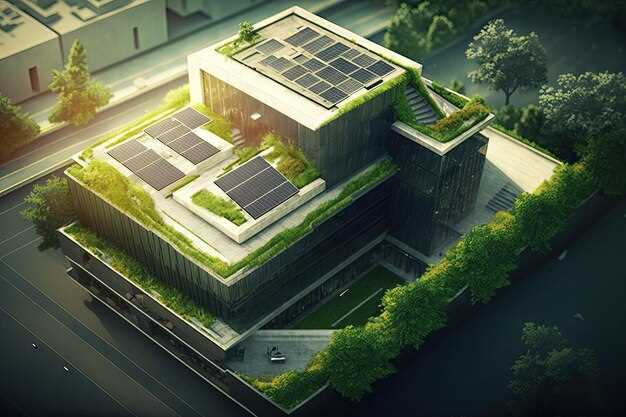
Within the realm of innovative and environmentally conscious design lies a captivating integration of nature’s most powerful resource – the sun. As forward-thinking architects and engineers rethink traditional blueprints, they seek to seamlessly incorporate the radiant energy of the sun into their architectural creations, taking advantage of its limitless potential. By considering alternative approaches to architectural composition, professionals explore the profound impact that solar power can have on the construction industry, allowing structures to harmoniously coexist with their surroundings while reducing their carbon footprint and energy consumption.
Embracing the essence of renewable energy, this concept transcends the traditional boundaries of design and engineering. It requires a shift in mindset, challenging professionals to think beyond conventional methodologies. Fusing creativity with eco-awareness, architects now strive to create spaces that not only excel in functionality and aesthetics but also serve as a testament to sustainability. Through intelligent design solutions, these visionaries aim to capture the essence of the sun’s energy and transform it into a viable source of power, revolutionizing the way buildings interact with the elements and their inhabitants.
Imbued with a vision firmly rooted in a greener future, these sustainable architectural pioneers pave the way for a new era of construction. They understand that the integration of solar power signifies more than just adopting an alternative energy solution; it symbolizes a commitment to preserving the environment and ensuring a brighter future for generations to come. By harnessing the sun’s rays, these architects not only provide a clean and renewable power source but also foster a deeper connection between humans and their surroundings, blurring the lines between the built environment and the natural world.
With each new innovation in solar design, the boundaries of architecture continue to expand, enabling structures to adapt organically to their environment. From energy-efficient building materials to intelligent shading systems, these eco-minded designers utilize cutting-edge technologies, allowing sunlight to become an integral part of the building’s fabric. This harmonious marriage between nature and design, between form and function, ultimately reflects a profound commitment to creating spaces that not only inspire but also preserve the beauty and vitality of our world.
Sustainable Building Design: Incorporating Photovoltaic Energy into Architectural Blueprints
In this section, we explore the innovative integration of photovoltaic energy sources within the framework of sustainable building design. By seamlessly blending solar technology into architectural blueprints, designers can harness the transformative power of the sun to create environmentally-friendly structures that generate clean, renewable energy.
The Advantages of Harnessing Solar Energy in the Creation of Sustainable Architectural Blueprints
In the realm of sustainable architectural planning, one innovation that has transcended traditional designs is the incorporation of solar power. This groundbreaking renewable energy source offers an array of benefits, further enhancing the potential of sustainable building projects. By harnessing the capabilities of solar power, architects can address environmental concerns while simultaneously promoting energy efficiency and cost savings, paving the way for a greener future.
|
1. Efficient Energy Generation One of the remarkable advantages of integrating solar power into architectural plans is the efficient generation of energy. Solar panels, strategically positioned on the building, effectively absorb sunlight and convert it into electricity. This sustainable energy solution generates power in a clean and eco-friendly manner, reducing the dependence on fossil fuels and diminishing harmful greenhouse gas emissions. |
2. Cost-Effectiveness Another significant benefit of incorporating solar power into architectural blueprints is the long-term cost savings it offers. Once implemented, solar energy systems significantly reduce electricity bills by supplementing traditional energy sources. Moreover, with advancements in technology, solar panels have become more affordable and durable, making it a financially feasible choice for sustainable building projects. |
|
3. Architectural Versatility The integration of solar power enhances architectural versatility by providing an opportunity for innovative and aesthetically pleasing designs. Solar panels can be seamlessly integrated into the building’s façade or roof, blending functionality with the overall aesthetics of the structure. This integration not only adds to the visual appeal but also showcases the commitment to sustainable practices, inspiring others to embrace environmental consciousness. |
4. Energy Independence Solar power enables sustainable buildings to achieve a level of energy independence. By generating their own electricity, these buildings become less reliant on external energy grids and are more resilient in the face of power outages. This energy independence not only provides stability but also promotes a sense of self-sufficiency, allowing for uninterrupted operations and increased reliability. |
In conclusion, the benefits of solar power in sustainable architectural design are extensive, encompassing efficient energy generation, cost-effectiveness, architectural versatility, and energy independence. Integrating solar power into architectural blueprints not only contributes to a greener environment but also showcases a commitment to sustainable practices, setting a powerful example for future sustainable building designs.
Designing for Solar: Incorporating Photovoltaic Systems into Architecture
In this section, we will explore the innovative approach of integrating photovoltaic systems into architectural designs to harness solar energy. By seamlessly incorporating solar panels into the architectural framework, buildings can generate renewable energy while maintaining an aesthetically pleasing design.
Maximizing Energy Efficiency
One key aspect of incorporating photovoltaic systems into architecture is the emphasis on maximizing energy efficiency. Architects and designers must consider factors such as building orientation, shading, and materials to optimize the performance of solar panels. By strategically positioning solar panels to capture the most sunlight throughout the day and integrating efficient building materials, structures can generate a greater amount of solar energy.
Seamless Integration into Design
Creating visually appealing designs that seamlessly integrate solar panels is crucial in promoting the widespread adoption of photovoltaic systems in architecture. Architects are exploring various techniques, such as incorporating solar panels into building facades, rooftops, and even windows. These innovative solutions not only enhance the building’s aesthetics but also demonstrate the seamless merging of renewable energy generation with architectural design.
- Building facades: Architects are now designing facades with built-in solar panels, transforming them into functional energy-generating surfaces. These panels can be integrated as cladding materials or arranged in aesthetically pleasing patterns to complement the building’s overall design.
- Rooftops: Rooftops offer vast areas for solar panel installation. By utilizing these spaces effectively, architects can seamlessly incorporate solar modules into the overall architectural design, providing a sustainable energy solution without compromising the building’s aesthetic appeal.
- Windows: Transparent photovoltaic coatings and solar windows are emerging technologies that allow for the integration of solar energy generation while maintaining a clear view. These innovative solutions enable architects to incorporate solar panels into the design of windows, further maximizing energy production without obstructing natural light.
By embracing the integration of photovoltaic systems into architecture, we can create sustainable buildings that generate clean energy while blending seamlessly into their surroundings. This innovative approach not only benefits the environment but also promotes a more sustainable future for the architectural industry.
Innovations in Solar Panels: Efficient and Aesthetically Pleasing Designs
Solar panels have come a long way in recent years, evolving from simple, clunky devices into efficient and visually appealing elements of architectural design. This section explores the exciting innovations that have transformed solar panels into both functional and aesthetically pleasing features of sustainable construction.
Recent advancements in solar panel technology have focused on enhancing their efficiency while also improving their visual integration into the built environment. These new designs have gone beyond the traditional bulky forms, seamlessly integrating solar panels into architectural elements such as windows, roof tiles, and facades.
One noteworthy innovation is the development of transparent solar panels that can be used as windows or skylights. These panels are designed to capture sunlight and convert it into electricity while still allowing natural light to pass through. This breakthrough enables architects to incorporate solar power generation into the very fabric of a building without sacrificing aesthetic appeal.
Another exciting development is the use of solar panels with customizable designs. These panels can be produced in various shapes, patterns, and colors, allowing architects to incorporate them as artistic elements in their designs. These aesthetically pleasing solar panels not only generate clean energy but also enhance the overall visual appeal of the building.
Furthermore, advancements in materials have facilitated the production of lightweight and flexible solar panels, providing architects with greater freedom in their design choices. These lightweight panels can be easily integrated into curved surfaces or modular systems, opening up new possibilities for solar power inclusion in architectural projects.
Overall, by focusing on efficiency and aesthetics, innovations in solar panel design have transformed them from utilitarian devices to visually appealing and seamlessly integrated elements of sustainable architectural plans. The integration of efficient and aesthetically pleasing solar panels into building design not only contributes to the reduction of carbon footprint but also showcases the possibilities of combining clean energy generation with stunning architectural concepts.
Solar Integration: From Passive Solar Design to Active Solar Systems
Exploring the seamless integration of solar energy in architectural planning, this section delves into the progressive journey from passive solar design to active solar systems. It encompasses the evolution of utilizing the sun’s energy as a sustainable and efficient solution, from harnessing natural lighting and heat to the implementation of innovative technologies.
Passive solar design, the initial stage of solar integration, emphasizes utilizing the sun’s energy passively by strategically designing and positioning buildings. This approach optimizes natural lighting and uses materials that can effectively absorb and retain heat, reducing the need for artificial lighting and cooling systems. The integration of passive solar design principles not only enhances energy efficiency but also provides a comfortable and healthy environment for occupants, fostering sustainability on multiple levels.
As the realm of sustainable architecture continues to evolve, active solar systems have emerged as a cutting-edge solution for maximizing the utilization of solar energy. Active solar systems actively convert solar radiation into electricity or heat through the use of photovoltaic panels or solar collectors. These systems enable buildings to generate renewable energy, reducing reliance on traditional power sources and contributing to a greener future. With the rapid advancements in technology, active solar systems now offer an array of options, ranging from solar panels on rooftops to solar facades integrated into building envelopes.
Furthermore, the integration of active solar systems goes beyond energy production. It presents an opportunity to incorporate innovative design elements that seamlessly blend with the architectural aesthetic. Solar panels can be incorporated into building facades, creating visually striking patterns and enhancing the building’s overall design. This synergy between solar integration and architectural aesthetics enables the creation of eco-friendly structures that are both functional and visually appealing.
- Passive solar design optimizes natural lighting and heat absorption.
- Active solar systems actively convert solar energy into electricity or heat.
- Integration of active solar systems goes beyond energy production and contributes to innovative architectural design.
Overall, the integration of solar energy in architectural plans warrants a comprehensive understanding of both passive solar design and active solar systems. By seamlessly blending sustainability and functionality, buildings can harness the power of the sun to create ecologically conscious, energy-efficient, and visually stunning structures.
Overcoming Challenges: Considerations for Successful Solar Implementation
Addressing the hurdles and potential roadblocks that arise when incorporating solar technology into architectural plans is essential for achieving successful and efficient integration. This section explores the various considerations and strategies that can help overcome these challenges, ensuring the effective implementation of solar power systems.
1. Infrastructural Adaptability: One of the primary challenges of solar implementation lies in the need for infrastructural modifications to support the integration of solar power systems. This requires careful planning and coordination with contractors and engineers to ensure proper installation and compatibility with existing building structures and electrical systems. Additionally, considerations must be given to the available space for solar panel placement and the capacity of the system to meet the energy demands of the building.
2. Financial Feasibility: Implementing solar power systems can involve significant upfront costs, making financial feasibility a crucial consideration. To overcome this challenge, architects and project developers must conduct thorough cost-benefit analyses, considering factors such as government incentives, long-term energy savings, and potential revenue generation through excess energy production. Collaborating with renewable energy financing experts can also provide valuable insights and options for funding solar projects.
3. Aesthetic Integration: Incorporating solar power systems into architectural designs poses a challenge in terms of maintaining aesthetic harmony. Architects must find creative ways to seamlessly integrate solar panels into the building’s design, ensuring that they complement the overall aesthetic without detracting from its visual appeal. This may involve utilizing building-integrated photovoltaics or incorporating solar elements into shading devices, facades, or roof structures.
4. Technical Expertise: Successful solar implementation requires collaboration with technical experts, including solar engineers and energy consultants. These professionals possess the necessary expertise to assess the building’s energy needs accurately, design efficient solar systems, and ensure their proper installation and operation. Architects must actively engage with these experts throughout the design and construction process to optimize solar performance and address any technical challenges that may arise.
5. Regulatory Compliance: Meeting regulatory requirements and obtaining necessary permits and approvals can be a complex and time-consuming process. Architects must keep abreast of local building codes, zoning regulations, and renewable energy policies to ensure compliance when incorporating solar power systems. Collaborating with legal and regulatory experts can help navigate this aspect and streamline the permitting and approval process.
In conclusion, successfully integrating solar power into architectural designs necessitates overcoming various challenges related to infrastructure, finances, aesthetics, technical aspects, and regulatory compliance. By addressing these considerations strategically and collaboratively, architects can ensure the effective implementation of sustainable solar energy systems, contributing to the overall sustainability and energy efficiency of buildings.


